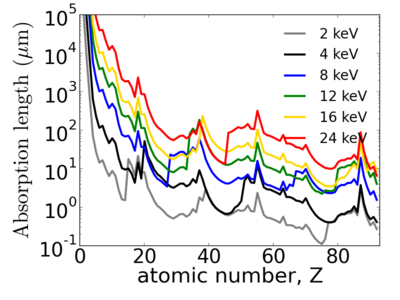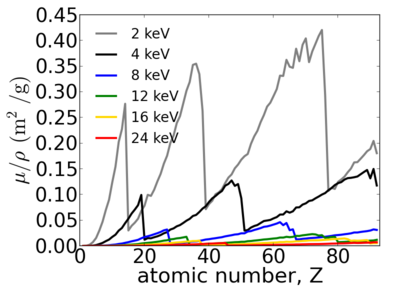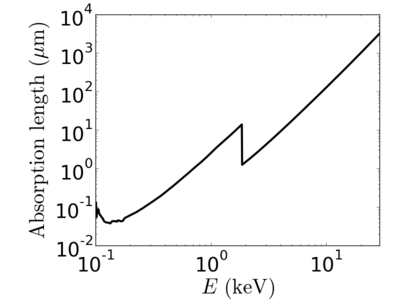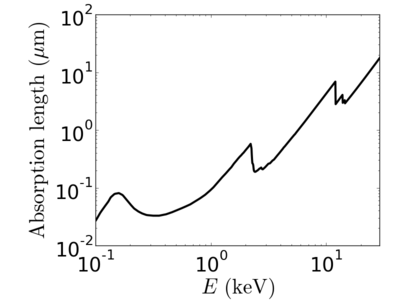|
|
| (One intermediate revision by the same user not shown) |
| Line 121: |
Line 121: |
| | ==See Also== | | ==See Also== |
| | * [[Resonant scattering]] | | * [[Resonant scattering]] |
| | + | ** [[RSoXS]] |
| | + | ** [[Resonant reflectivity]] |
| | * [http://henke.lbl.gov/optical_constants/atten2.html LBL X-Ray Attenuation Length calculator] | | * [http://henke.lbl.gov/optical_constants/atten2.html LBL X-Ray Attenuation Length calculator] |
| | * [http://11bm.xray.aps.anl.gov/absorb/absorb.php APS absorption calculator] | | * [http://11bm.xray.aps.anl.gov/absorb/absorb.php APS absorption calculator] |
| | + | * [http://henke.lbl.gov/optical_constants/filter2.html CXRO transmission calculator] |
| | * [http://en.wikipedia.org/wiki/Mass_attenuation_coefficient Wikipedia: Mass attenuation coefficient] | | * [http://en.wikipedia.org/wiki/Mass_attenuation_coefficient Wikipedia: Mass attenuation coefficient] |
| | * [http://en.wikipedia.org/wiki/Absorption_cross_section Wikipedia: Absorption cross sectio] | | * [http://en.wikipedia.org/wiki/Absorption_cross_section Wikipedia: Absorption cross sectio] |
| | * [http://www.nist.gov/pml/data/xraycoef/ NIST tables of x-ray mass attenuation coefficient] | | * [http://www.nist.gov/pml/data/xraycoef/ NIST tables of x-ray mass attenuation coefficient] |
Latest revision as of 15:43, 29 July 2015
The absorption length or attenuation length in x-ray scattering is the distance over which the x-ray beam is absorbed. By convention, the absorption length ϵ is defined as the distance into a material where the beam flux has dropped to 1/e of its incident flux.
Absorption
The absorption follows a simple Beer-Lambert law:

The attenuation coefficient (or absorption coefficient) is simply the inverse of the absorption length; 

Calculating
The absorption length arises from the imaginary part of the atomic scattering factor, f2. It is closely related to the absorption cross-section, and the mass absorption coefficient. Specifically, the atomic photoabsorption cross-section can be computed via:

Where λ is the x-ray wavelength, and re is the classical electron radius. The attenuation coefficient is given by:

where ρ is density, Na is the Avogadro constant, and ma is the atomic molar mass. Note that the mass attenuation coefficient is simply  .
.
Elemental dependence


Energy dependence
Notice that the absorption undergoes sharp increases when passing through an absorption edge.
Examples




Elemental/Energy dependence


Related forms
As can be seen, there are many related quantities which express the material's absorption:
- Absorption length
 , the distance over which the intensity falls to 1/e.
, the distance over which the intensity falls to 1/e.
- Attenuation coefficient
 , the characteristic inverse-distance for attenuation.
, the characteristic inverse-distance for attenuation.
- Mass attenuation coefficient
 , the density-scaled attenuation.
, the density-scaled attenuation.
- Absorptive atomic scattering factor
 , the intrinsic dissipative interaction of the material.
, the intrinsic dissipative interaction of the material.
- Atomic photoabsorption cross-section
 , the cross-section ('effective size') of the atom's x-ray absorption (capture) efficiency.
, the cross-section ('effective size') of the atom's x-ray absorption (capture) efficiency.
- Imaginary refractive index
 , the resonant component of the refractive index.
, the resonant component of the refractive index.
- Imaginary Scattering Length Density
 , the absorptive component of the scattering contrast.
, the absorptive component of the scattering contrast.

|

|

|

|

|

|

|

|

|

|

|

|

|

|

|

|

|

|

|

|

|

|

|

|

|

|

|

|

|

|

|

|

|

|

|

|

|

|

|

|

|

|

|

|

|

|

|

|

|
See also scattering factors for a comparison of the quantities related to f1.
See Also



























































